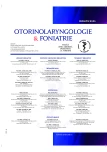Embolization Therapy of Epistaxis
Authors:
M. Šercl 1; V. Šerclová 2; H. Havrdová 3; V. Mellanová 1; V. Machačka 1; L. Endrych 1
Authors‘ workplace:
RDG oddělení Krajská nemocnice Liberec a. s.
1; ORL oddělení Městská nemocnice Jablonec nad Nisou
2; ORL oddělení Krajská nemocnice Liberec a. s.
3
Published in:
Otorinolaryngol Foniatr, 68, 2019, No. 2, pp. 79-85.
Category:
Original Article
Overview
Objective: Objective of this study is to retrospectively evaluate a cohort of patients with intractable epistaxis treated by endovascular embolization.
Methods: A total number of 311 patients with intractable epistaxis were admitted in Liberec Regional Hospital and Jablonec nad Nisou City Hospital between 2009 and 2017, out of these 31 were managed by endovascular treatment. Risk factors, type of embolization therapy, clinical outcome and complications were reviewed retrospectively.
Results: In our cohort of 31patients clinical success rate of the first embolization attempt was 83.9%, which increased to 96.8% following escalation of the embolization extent. In one case we had to abandon the procedure due to technical issues. We encountered one major permanent complication (2.6%), one major transient complication (2.6%), which was managed at the time of the procedure with a complete resolution of clinical symptoms and a total number of 4 minor transient complications (10,6%) – one septal decubitus, which healed within 4 weeks after the procedure, and three cases of headache, which was managed by analgesia. Early recurrence rate was 16.1%, in all cases managed by re-embolization. Failure of endovascular treatment which necessitated surgery was encountered in 3.2% cases.
Conclusion: Endovascular treatment proves to be an effective tool in management of retractable epistaxis. It offers a good risk-benefit profile and is easily repeated should the first attempt not be successful.
Keywords:
posterior nasal packing – epistaxis – maxillary artery
Sources
1. Cihlář, F., Prokopová, Z., Šmolka, V. et al.: Endovaskulární léčba refrakterní epistaxe. Ces Radiol, 71, 2017, 2, s. 132-136.
2. Cullen, M. M., Tami, T. A.: Comparison of internal maxillary artery ligation versus embolization for refractory posterior epistaxis. Otolaryngol Head Neck Surg, 118, 1998, 5, s. 636-642.
3. Dubel, G. J., Ahn, S. H., Soares, G. M.: Transcatheter embolization in the management of epistaxis. Semin Intervent Radiol, 30, 2013, 3, s. 249-262.
4. Flint, P. W. et al.: Cummings Otolaryngology-Head and Neck Surgery: Head and Neck Surgery, 3-Volume Set. 5th Ed. Elsevier Health Sciences 2010, s. 682-693.
5. Geibprasert, S., Pongpech, S., Armstrong, D. et al.: Dangerous extracranial-intracranial anastomoses and supply to the cranial nerves: vessels the neurointerventionalist needs to know. AJNR Am J Neuroradiol, 30, 2009, 8, s. 1459-1468.
6. Charvát, F., Markalous, B. et al.: Zobrazení hlavy: metodika vyšetřování, anatomie, patologie, klinika: CT, MR, RTG, PET, PET/CT, sonografie, endoskopie, angiografie, intervenční neuroradiologie, navigovaná chirurgie, 2. upr. vydání, Praha: Triton, 2006.
7. Ismail, H., Buckland, J. R., Harries, P. G.: The prevention of alar necrosis in Foley catheter fixation in posterior epistaxis. Ann R Coll Surg Engl, 86, 2004, 4, s. 307.
8. Klotz, D. A., Winkle, M. R., Richmon, J. et al.: Surgical management of posterior epistaxis: a changing paradigm. Laryngoscope, 112, 2002, 9, s. 1577-1582.
9. Koh, E., Frazzini, V. I., Kagetsu, N. J.: Epistaxis: vascular anatomy, origins, and endovascular treatment. AJR Am J Roentgenol, 174, 2000, 3, s. 845-851.
10. Krajina, A., Chrobok, V.: Radiological diagnosis and management of epistaxis. Cardiovasc Intervent Radiol, 37, 2014, 1, s. 26-36.
11. Rodesch, G. et al.: Embolization of Epistaxis. In Golzarian, J., et al. Vascular embolotherapy. Vol. 2., Berlin: Springer 2006; s. 252-266.
12. Russell, E. J.: Functional angiography of the head and neck. AJNR Am J Neuroradiol, 7, 1986, 5, s. 927-936.
13. Schalek, P.: Endonazální endoskopická koagulace a. sphenopalatina v léčbě závažné epistaxe ze zadních oddílů nosní dutiny. Otorinolaryng a Foniat /Prague/, 60, 2011, 1, s. 43-45.
14. Sokoloff, J., Wickbom, I., McDonald, D. et al.: Therapeutic percutaneous embolization in intractable epistaxis. Radiology, 111, 1974, 2, s. 285-287.
15. Small, M., Murray, J. A., Maran, A. G.: A study of patients with epistaxis requiring admission to hospital. Health Bull (Edinb), 40, 1982, 1, s. 20-29.
16. Strong, E. B., Bell, D. A., Johnson, L. P. et al.: Intractable epistaxis: transantral ligation vs. embolization: efficacy review and cost analysis. Otolaryngol Head Neck Surg, 113, 1995, 6, s. 674-678.
17. Tseng, E. Y., Narducci, C. A., Willing, S. J. et al.: Angiographic embolization for epistaxis: a review of 114 cases. Laryngoscope, 108, 1998, 4 Pt 1, s. 615-619.
18. Valavanis, A., Setton, A.: Embolization of Epistaxis. In: Valavanis, A. (eds) Interventional Neuroradiology. Medical Radiology (Diagnostic Imaging and Radiation Oncology). Berlin: Heidelberg Springer, 1993.
19. Viducich, R. A., Blanda, M. P., Gerson, L. W.: Posterior epistaxis: clinical features and acute complications. Ann Emerg Med, 25, 1995, 5, s. 592-596.
Labels
Audiology Paediatric ENT ENT (Otorhinolaryngology)Article was published in
Otorhinolaryngology and Phoniatrics

2019 Issue 2
Most read in this issue
- ideo Head Impulse Test – a Novel Method for Examination of Vestibular Apparatus
- The Effect of Voice Training Using Humming Resonance Exercises at Students – Preliminary Study
- Inverted Sinonasal Papilloma: Possibility of Prediction of the Tumor Insertion
- Solitary Fibrous Tumour of the Parotid Gland. Case Report and Review of the Literature
